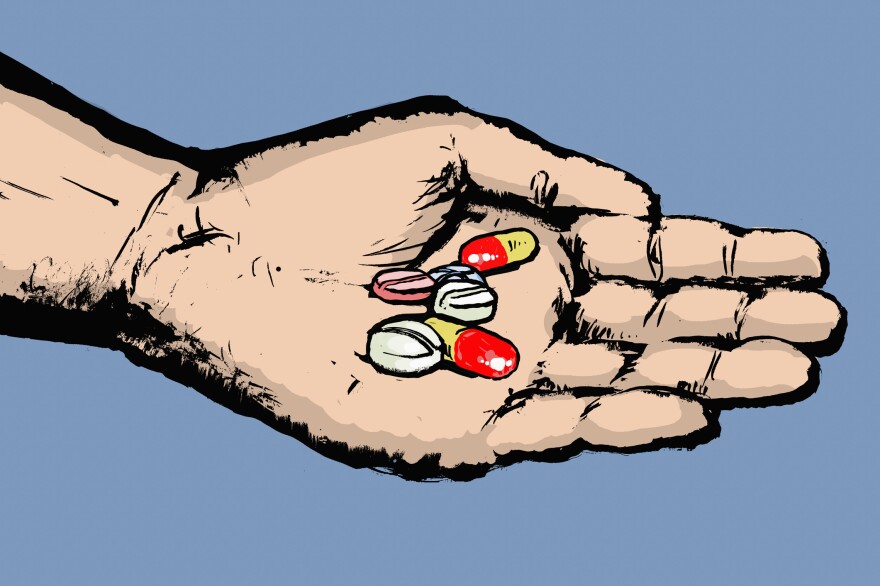This story is a collaboration between the Border Belt Independent and The Assembly.
Carisa Collins-Caddle pulled her Ford Edge into a Food Lion parking lot in Lumberton, a city in Robeson County, North Carolina, and looked down at her phone. A young woman struggling with drug use had reached out to her earlier about meeting to get clean syringes.
A few minutes later, the woman’s boyfriend approached and Collins-Caddle popped open the SUV’s hatch. Inside, organized and labeled like art supplies in a school classroom, were needles, alcohol swabs, at-home fentanyl test strips, and naloxone, which can reverse the effects of a drug overdose.
“Don’t share needles, don’t reuse,” Collins-Caddle reminded the soft-spoken man as she added condoms, sanitary pads, and tampons to a plastic bag for him and his girlfriend.
This is how most of Collins-Caddle’s Monday mornings begin. As the only outreach worker in Robeson County for the North Carolina Harm Reduction Coalition, she starts her work week driving about 100 miles along back roads to meet clients who misuse opioids and other drugs. Her goal, she says, is to teach people who are already addicted how to administer drugs safely until they are ready and able to get the help they need to stop using.
There are many challenges in Robeson, a sprawling southeastern county of 116,000 people and an epicenter of the opioid epidemic in North Carolina. The state saw a 22% increase in drug overdose deaths between 2019 and 2021; Robeson saw a 49% increase.
Read the rest of this story at The Border Belt Independent.
Kelly Kenoyer: welcome Sarah Nagem, editor of the border belt independent.
Sarah Nagem: Thank you for having me.
KK: So in your story about the war on drugs in Robeson County you called Robeson County the epicenter of the opioid epidemic in North Carolina. Why is that?
SN: Well, the opioid epidemic has impacted every part of the state really every part of the country, right? Robeson County has been hit particularly hard. North Carolina saw a 22% increase in drug overdose deaths between 2019 and 2021, Robeson County saw a 49% increase during that same time. So, you know, it's obvious that something is going on there, that that community has been disproportionately affected.
KK: What does the crisis feel like on the ground in Robeson County?
SN: It feels a lot like hopelessness in a lot of ways. And that's what's really heartbreaking about it. You know, we are really in the third decade of the opioid epidemic, it really began in the late 90s. You know, so many people were prescribed painkillers, sort of inadvertently got hooked on them. And then sort of, you know, we entered this, this other wave and, you know, around 2010, where those prescriptions became harder and harder to get right from doctors from pharmacies. And of course, that was a policy shift. People went to heroin, because they were already hooked. And then, of course, it changed again, where fentanyl became widely available. And people often graduated from heroin to fentanyl. And, you know, it's gone on for so long, that in a lot of families, two generations are affected. I met one woman, her ex-husband died of an opioid overdose. And then her daughter was really struggling as well.
KK: What are the best practices for fighting the opioid epidemic?
SN: Yeah, you know, in reporting the story, that's really the heart of what I wanted to get to county commissioners, city councils across the state are getting this big infusion of money. And they kind of have a lot of discretion about how to spend it. So that was really the heart of my reporting, okay, you're getting all this money? What is the best way to spend it to really make a difference in communities? I think the main takeaway for me is that there is no one size fits all approach. You know, a lot of people respond really well to 12 Step programs like Narcotics Anonymous, others say complete abstinence at first doesn't work for me. I need medication-assisted treatment, drugs that are approved by the FDA. And you know, some people probably need to go to a detox center where others may not. One thing that I did hear a lot of is that it's good to get treatment outside of your immediate community. You know, maybe you know, you got high with friends, maybe being away from that environment for a while, will help in the recovery process.
KK: I mean, you mentioned the money that's coming in Robeson County got $16 million from the opioid settlement fund at the state level. So what's the plan for how to use it?
SN: So far? Robeson county commissioners have not been super open about that. So one thing Robeson County did is looking to this consortium is the Robertson rural communities opioid Response Program is a consortium that includes law enforcement, health officials. So this consortium kind of came together and gave recommendations. So they suggested that first round go to programs such as drug courts in Robeson County, to the North Carolina Harm Reduction Coalition. So, you know, it really is across the gamut. I reached out to the county manager's office and said, Hey, have y'all made any decisions? And what I heard back was that they have awarded some money to a couple organizations, but didn't respond to follow-up questions about which organizations they are and how much money they got. All this money is coming in. How are folks can be held accountable about where it goes?
KK: Yeah, you'd hoped for more transparency from the county on that one. All right. Thank you so much for your time, Sarah, I appreciate it.
SN: Well, thank you.

